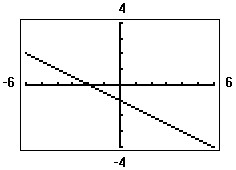Solve the problem.Consider the rational inequality  < 0. Without doing any work, give the solution set. (Hint: determine the sign of the numerator and denominator.)
< 0. Without doing any work, give the solution set. (Hint: determine the sign of the numerator and denominator.)
A. ?
B. (-?, ?)
C. (5, 6)
D. (5, ?)
Answer: A
Mathematics
You might also like to view...
Find the equilibrium solutions of the equation of change 
A. 
B. 
C. 
D. 
Mathematics
Provide an appropriate response. Which statement illustrates the correct use of the distributive property of multiplication?
A. 5(11 + 9) = 100 B. 5(11 + 9) = 55 + 9 C. 5(11 + 9) = 5 + (20) D. 5(11 + 9) = 55 + 45
Mathematics
Solve the problem.Find an equation in general form for the line graphed on a graphing utility. 
A. 2x + y = -1
B. x + 2y = -2
C. y = -2x - 1
D. y = -  x - 1
x - 1
Mathematics
An investment is made at 8.085% per year, compounded continuously. What is the doubling time? Round to the nearest year.
What will be an ideal response?
Mathematics



